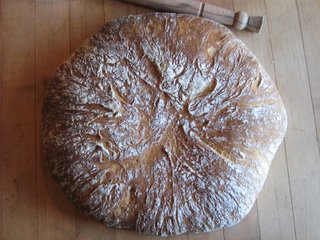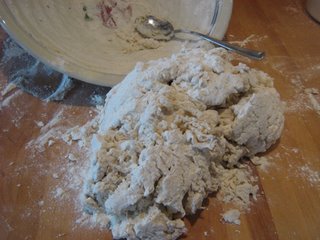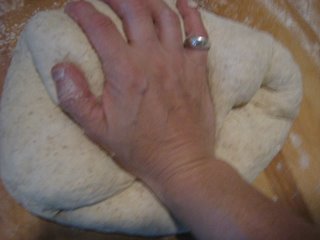A Work in ProgressAll right, I just figured out how to put a picture on the blog. There have been some requests for photos, so here we go. I thought I would throw up (pun intented as I've eaten a ridiculous amount of icing, not to mention the finished cake), a bunch of snaps on a little cake I'm working on...I'm trying to make the perfect mocha cake. The cake is a devil's food style made with buttermilk and coffee,(espresso), the ganache is white chocolate blended with a little milk chocolate, whip cream and espresso.

I just like the way this looks with a huge glop of whipped ganache on top.

This has two crumb coats of the ganache on it, and this new glop on top is a chocolate butter cream that was pretty much perfect. I had gotten the sugar syrup a little too hot, (only because I am too lazy to dump it into a pyrex cup to cool it. Ideally I heat it to just below the required string stage - or whatever it is called - an let it cook a few more moments in the pan, (very naughty if you are a perfectionist control freak), while I get my timing together, which you will probably surmise after seeing my eventual fridge photo, is a bloody miracle. Any way, the sugar syrup was mother fricken hot, and made smooth diamond hard and glittering splatters on the inside of my workbowl, ( insert expletives here), if I added it too fast. BUT, The resulting meringue was perfectly stiff but still yeilded to the butter. It had no problem taking on the generous load of bittersweet chocolate I added. And voila, that is the said buttercream on top.

This is the almost finished cake, with its random mounds on top.

Side view, before the kids got a hold of the little white sugar balls. Actually, just took a closer look, and its an after shot....lots of sugar.

OK, the top shot, and we are almost done.

We promptly ate the thing, so its only right that you can see the sloppy interior. Having not taken the time to cool the cake between each layer you can see it sag and crumble. But looks aren't everything, and it tasted not too bad.

This is the best picture. My fridge is just like my mind. There is lots of stuff in there, all ready to be used if I just took the time to rifle through all that crap instead of just shoving more in there.
For any of you that actually slogged through all of this, (Candy, I know you made it this far if only to see if I made any hilarious spelling mistakes), I want to take this opportunity to tell you what I think a buttercream icing should be.
It should melt in your mouth in such a way that you need to have another taste - that means no weird fat additives other than butter.
There should be no grainy texture. If satin were food, it would be buttercream.
All flavourings should not overpower the buttercream. Ideally you should go through a process where the flavours kind of rise and fall with each mouthful. Has anyone tasted durian? Its weird stinky stuff, but the flavour is un-fricken believeable - its like the chameleon of the food world....berries, garlic, citrus, fungus... the flavour changes pound you like big surf. Well buttercream should have those waves of flavour, but in a more subtle motion, perhaps like the gentle laps of a protected harbour.
I'm sure I have more to say on cakes, icing and ganache, (don't get me started, at least not yet, on chocolate). I'm also very fussy about coffee, and that is an understatement.
I guess I shouldn't go without including at least one recipe.
Whipped Mocha Ganache
Ingredients:
double shot of espresso, or more if you like
1 1/2 cups whip cream, (approx.)
13 oz. white chocolate
4 oz. milk chocolate
Preparation:
1. Pour the espresso into a 2 cup liquid measuring cup.
2. Add whip cream to the 1 1/2 cup mark.
3. In a double boiler, or in a st. st. bowl set over over simmering water, combine the chocolates and whip cream, stir really often until melted.
4. Cool and store in the refrigerater until ready to use.
It must be fridge cold 5. To use whip until firm peaks form. This doesn't take long in an upright mixer. It will seem like forever if you do it by hand. Use immediately.
This will fill two layers and the exterior crumb coat, (a very thin exterior coat), of an 8' cake. OK, I'm taking an educated guess here. The little cake you saw today was 6 1/2' inches, and it had a ridiculous amount of ganache icing in it and on it, plus the butter cream.
Note: I find heating the white chocolate in a double boiler/baine marie a much safer method than the microwave since white chocolate burns very easily at low temperatures giving you a grainy result. On the stove you need to stir it lots and then you can watch for over heating.
If you have any questions, or anything seems unclear, don't hesitat to let me know.





























